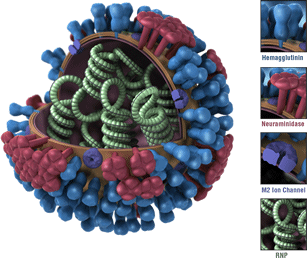Influenza Antiviral Drug Resistance
Questions & Answers
On This Page
- What are reduced susceptibility and antiviral resistance?
- How widespread are reduced susceptibility and antiviral resistance in the United States?
- How does reduced susceptibility and antiviral resistance happen?
- How are reduced susceptibility and antiviral resistance detected?
- How has CDC prepared to test for reduced susceptibility and antiviral resistance to the new flu antiviral baloxavir?
- What is oseltamivir resistance and what causes it?
- How does CDC improve monitoring of influenza viruses for reduced susceptibility and antiviral resistance?
- How did influenza antiviral susceptibility patterns change during the previous (2017-2018) influenza season?
- What can people do to protect themselves against flu viruses with reduced susceptibility and antiviral resistance?
- What implications do reduced susceptibility and antiviral resistance have for the U.S. antiviral stockpile that was created as part of the United States pandemic plan?
What are reduced susceptibility and antiviral resistance?
Antiviral “reduced susceptibility” and “antiviral resistance” mean (respectively) that a virus changes in such a way that antiviral drugs are less effective, or not effective in treating or preventing illnesses with that virus. Influenza viruses, which are constantly changing, can become less susceptible or resistant to one or more influenza antiviral drugs. If a virus is susceptible to an antiviral drug, this means the antiviral drug is fully effective against the virus. Reduced susceptibility can be a sign of lower effectiveness or developing antiviral resistance.
In the United States, there are four FDA-approved antiviral drugs recommended by CDC this season. Three are neuraminidase inhibitor antiviral drugs: oseltamivir (available as a generic version or under the trade name Tamiflu®) for oral administration, zanamivir (trade name Relenza®) for oral inhalation using an inhaler device, and peramivir (trade name Rapivab®) for intravenous administration. The fourth is a cap-dependent endonuclease (CEN) inhibitor, baloxavir marboxil (trade name Xofluza®) for oral administration, approved for use in the United States during the 2018-2019 season by FDA in October of 2018.
There is another class of influenza antiviral drugs (amantadine and rimantadine) called the adamantanes (which have activity against only influenza A viruses) that are not recommended for use in the United States at this time because of widespread antiviral resistance in circulating influenza A viruses.
How widespread are reduced susceptibility and antiviral resistance in the United States?
In the United States, most of the recently circulating influenza viruses have been fully susceptible to the neuraminidase inhibitor antiviral medications and to baloxavir. On the other hand, many flu A viruses are resistant to the adamantane drugs which is why they are not recommended for use at this time.
How does reduced susceptibility and antiviral resistance happen?
Influenza viruses are constantly changing; they can change from one season to the next and can even change within the course of one flu season. As a flu virus replicates (i.e., make copies of itself), the genetic makeup may change in a way that results in the virus becoming less susceptible to one or more of the antiviral drugs used to treat or prevent influenza. Influenza viruses can become less susceptible to antiviral drugs spontaneously or emerge during the course of antiviral treatment. Viruses that are less susceptible or resistant vary in their ability to transmit to other people.
How are reduced susceptibility and antiviral resistance detected?
CDC routinely tests flu viruses collected through domestic and global surveillance to see if they have indications of reduced susceptibility to any of the FDA-approved flu antiviral drugs, as this can suggest the potential for antiviral resistance. This data informs public health policy recommendations about the use of flu antiviral medications.
Detection of reduced susceptibility and antiviral resistance involves several laboratory tests, including specific functional assays and molecular techniques (sequencing and pyrosequencing) to look for genetic changes that are associated with reduced antiviral susceptibility.
Top of PageHow has CDC prepared to test for reduced susceptibility and antiviral resistance to the new flu antiviral baloxavir?
CDC’s Influenza Division has taken specific laboratory actions to incorporate the new antiviral drug baloxavir into routine virologic surveillance. This includes the creation and validation of new assays to determine baloxavir susceptibility, and training of laboratorians to conduct baloxavir susceptibility testing.
Seasonal influenza A and B viruses in humans as well as several influenza A viruses that circulate in animals were tested to established baseline susceptibility to baloxavir. In addition, the susceptibility of other distantly related influenza viruses to baloxavir was tested. CDC also is collaborating with the Association of Public Health Laboratories (APHL) and the Wadsworth Center NYSDOH, a National Influenza Reference Center (NIRC), to establish laboratory-testing capacity for baloxavir susceptibility. CDC has trained staff within these partner organizations to use CDC’s new method for assessing baloxavir susceptibility.
What is oseltamivir resistance and what causes it?
Flu viruses are constantly changing (for more information, see How the Flu Virus Can Change. Changes that occur in circulating flu viruses typically involve the structures of the viruses’ two primary surface proteins: neuraminidase (NA) and hemagglutinin (HA). (See image below for a visualization of a flu virus and its HA and NA surface proteins.)

Oseltamivir is the most commonly prescribed of the recommended antiviral drugs in the United States that is used to treat flu illness. Oseltamivir is known as a “NA inhibitor” because this antiviral drug binds to NA proteins of a flu virus and inhibits the enzymatic activity of these proteins. By inhibiting NA activity, oseltamivir prevents flu viruses from spreading from infected cells to other healthy cells.
If the NA proteins of a flu virus change, oseltamivir can lose its ability to bind to and inhibit the function of the virus’s NA proteins. This results in “oseltamivir resistance” (non-susceptibility). A particular genetic change known as the “H275Y” mutation is the only known mutation to confer oseltamivir resistance in 2009 H1N1 flu viruses. The “H275Y’ mutation makes oseltamivir ineffective in treating illnesses with that flu virus by preventing oseltamivir from inhibiting NA activity, which then allows the virus to spread to healthy cells. The H275Y mutation also reduces the effectiveness of peramivir to treat influenza virus infections with this mutation.
Top of PageHow does CDC improve monitoring of influenza viruses for reduced susceptibility and antiviral resistance?
CDC continually improves the ability to rapidly detect influenza viruses with antiviral reduced susceptibility and antiviral resistance through improvements in laboratory methods; increasing the number of surveillance sites domestically and globally; and increasing the number of laboratories that can test for reduced susceptibility and antiviral resistance. Enhanced surveillance efforts have provided CDC with the capability to detect resistant viruses more quickly, and enabled CDC to monitor for changing trends over time.
Top of PageHow did influenza antiviral susceptibility patterns change during the previous (2017-2018) influenza season?
Antiviral susceptibility patterns changed very little in 2017-2018 compared with the previous season (2016-2017). During the 2016-2017 season, no oseltamivir resistance was found. During the 2017-2018 influenza season, only a small number of viruses were resistant to oseltamivir. Most of the influenza viruses tested during 2017-2018 continued to be susceptible to the antiviral drugs recommended for influenza by the Centers for Disease Control and Prevention (CDC) and the Advisory Committee on Immunization Practices (ACIP) (oseltamivir, zanamivir and peramivir). Resistance to the adamantane class of antiviral drugs among A/H3N2 and A/H1N1 viruses remained widespread (influenza B viruses are not susceptible to adamantane drugs).
Specifically, for the 2017-2018 season:
-
- CDC tested 1,147 influenza A(H1N1)pdm09, 2,354 influenza A(H3N2), and 1,118 influenza B viruses for reduced susceptibility and resistance to antiviral medications (i.e., oseltamivir, zanamivir, or peramivir).
- While the majority of the tested viruses showed susceptibility to the antiviral drugs, 11 (1.0%) A(H1N1)pdm09 viruses were resistant to both oseltamivir and peramivir, but were sensitive to zanamivir.
- As indicated by these results, oseltamivir, zanamivir, and peramivir remained recommended antiviral treatment options for flu illness during the 2017-2018 flu season.
- High levels of resistance to the adamantanes (amantadine and rimantadine) persisted among circulating influenza A viruses, and as adamantanes are also not effective against influenza B viruses—adamantane drugs were not recommended for use against influenza at this time.
CDC conducts ongoing surveillance and testing of influenza viruses for antiviral reduced susceptibility and resistance among seasonal and novel influenza viruses, and guidance is updated as needed.
Because there were no dramatic changes in antiviral susceptibility patterns during the 2017-2018 flu season, the guidance for the 2018-2019 flu season on the use of influenza antiviral drugs remains unchanged. The latest guidance for clinicians on the use of antiviral drugs for influenza is available on the CDC web site at Antiviral Drugs: Information for Health Professionals.
Top of PageWhat can people do to protect themselves against flu viruses with reduced susceptibility and antiviral resistance?
Getting a yearly seasonal flu vaccination is best way to reduce the risk of flu and its potentially serious complications. Flu vaccines protect against an influenza A(H1N1) virus, an influenza A(H3N2) virus, and one or two influenza B viruses (depending on the vaccine). CDC recommends that everyone 6 months of age and older get vaccinated each year. If you are in a group at high risk of serious flu-related complications and become ill with flu symptoms, call your doctor right away, you may benefit from early treatment with an influenza antiviral drug. If you are not at high risk, if possible, stay home from work, school and errands when you are sick. This will help prevent you from spreading your illness to others. See Important Information For People Sick With Flu for more information.
What implications do reduced susceptibility and antiviral resistance have for the U.S. antiviral stockpile that was created as part of the United States pandemic plan?
Antiviral drugs are one component of a multifaceted approach to pandemic preparedness planning and response. The U.S. Strategic National Stockpile (SNS) contains supplies of three neuraminidase inhibitor (NAI) antiviral medications, including oseltamivir (for oral administration), zanamivir (for oral inhalation) and peramivir (for intravenous administration). These medications are to be used in the event that a novel influenza A virus, such as avian influenza A(H7N9) virus, gains the ability to spread easily among people in a sustained manner, and is susceptible to NAI antiviral drugs. During the 2009 H1N1 pandemic, antiviral drugs were released from the SNS and used to treat infection with the pandemic virus, now referred to as influenza A(H1N1)pdm09 virus. Information about how antiviral drugs from the SNS were used during the 2009 H1N1 pandemic is available in The 2009 H1N1 Pandemic: Summary Highlights, April 2009-April 2010. Antivirals in the SNS are for use during public health emergencies in the United States, such as an influenza pandemic, but not for seasonal influenza epidemics. Since antiviral drug resistance can emerge in influenza viruses, including to the NAI antivirals, new antivirals with mechanisms of action that are different than the NAIs are needed for the SNS.
Top of Page- Page last reviewed: November 30, 2018
- Page last updated: November 30, 2018
- Content source:
- Centers for Disease Control and Prevention, National Center for Immunization and Respiratory Diseases (NCIRD)
- Page maintained by: Office of the Associate Director for Communication, Digital Media Branch, Division of Public Affairs



 ShareCompartir
ShareCompartir